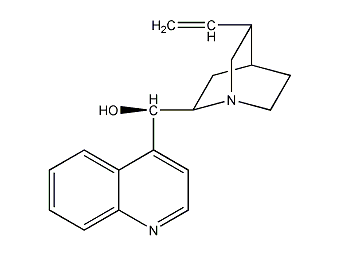Xin Koning


Structural formula
| Business number | 039K |
|---|---|
| Molecular formula | C19H22N2O |
| Molecular weight | 294.39 |
| label |
Cinchonine monohydrochloride dihydrate2-(5-Vinyl-2-quinyclidinyl)-4-quinolimethanol, Weak cinchona base;, antibiotic |
Numbering system
CAS number:118-10-5
MDL number:MFCD00064372
EINECS number:204-234-6
RTECS number:GD3500000
BRN number:89689
PubChem number:24888435
Physical property data
1. Properties: White or light yellow prismatic or needle-shaped crystals.
2. Density (g/mL, 20℃): Undetermined
3. Relative vapor density (g/mL, air=1): Undetermined
4. Melting point (ºC): 256-266
5. Boiling point (ºC, normal pressure): Undetermined
6. Boiling point (ºC, KPa): Undetermined
7. Refractive index: Undetermined
8. Flash point (ºC): Undetermined
9. Specific rotation (º): 229
10. Autoignition point or ignition temperature (ºC): Undetermined
11. Vapor pressure (mmHg, ºC): Undetermined
12. Saturated vapor pressure ( kPa, ºC): Undetermined
13. Heat of combustion (KJ/mol): Undetermined
14. Critical temperature (ºC): Undetermined
15. Critical pressure (KPa): Undetermined
16. Log value of oil-water (octanol/water) distribution coefficient: Undetermined
17. Explosion upper limit (%, V/ V): Undetermined
18. Lower explosion limit (%, V/V): Undetermined
19. Solubility: Easily soluble in hot ethanol, soluble in ethanol, chloroform, Ether, insoluble in water.
Toxicological data
1. Acute toxicity: rat intraperitoneal LD50: 152mg/kg
Mouse subcutaneous LCL0: 400mg/kg
Rana subcutaneous LDL0: 200mg/kg
p>
Ecological data
Slightly harmful to water.
Molecular structure data
1. Molar refractive index: 89.42
2. Molar volume (cm3/mol): 244.5
3. Isotonic specific volume (90.2K): 670.1
4. Surface tension (dyne/cm): 56.3
5. Polarizability (10-24cm3): 35.45
Compute chemical data
1. Hydrophobic parameter calculation reference value (XlogP): 2.7
2. Number of hydrogen bond donors: 1
3. Number of hydrogen bond acceptors: 3
4. Number of rotatable chemical bonds: 3
5. Number of tautomers:
6. Topological molecular polar surface area (TPSA): 36.4
7. Number of heavy atoms: 22
8. Surface charge: 0
9. Complexity: 412
10. Number of isotope atoms: 0
11. Determine the number of atomic stereocenters: 4
12. Uncertain number of atomic stereocenters: 0
13. Determine the number of chemical bond stereocenters: 0
14. The number of uncertain stereocenters of chemical bonds: 0
15. The number of covalent bond units: 1
p>
Properties and stability
1. Stable at room temperature and pressure, avoid contact with strong oxidants and light.
2.Reacts with a variety of inorganic ions to produce colored substances.
Storage method
1. Store in a cool, ventilated warehouse. Keep away from light. Keep away from fire and water sources.
2. They should be stored separately from oxidants and avoid mixed storage. Equipped with the appropriate variety and quantity of fire equipment.
3. The storage area should be equipped with suitable materials to contain leaks.
Synthesis method
1. Plant sources include the bark of the Rubiaceae plant red cinchona tree, the bark of cinchona, etc. It can also be biosynthesized into hydrochloride and tartrate. It has anti-plasmodial and antipyretic effects.
2. Cinchona bark can be extracted to obtain alkaloids. The crude product is dissolved with nitric acid and then precipitated with ammonia water. The resulting white precipitate is cinchonine. .
Purpose
1. Used for the determination of molybdenum and tungsten, photometric determination of bismuth, and verification of bismuth, antimony, germanium, cadmium, molybdenum and tungsten. Resolution of racemic organic acids.
2.Used for thin layer chromatography determination of bismuth, silver, mercury, lead, Reagents for antimony, vanadium, copper, and platinum ions. It is also used as an indicator for precipitation titration determination of iodide.
